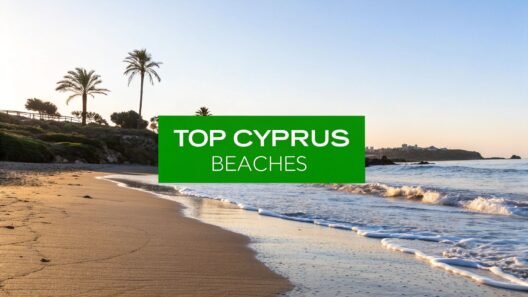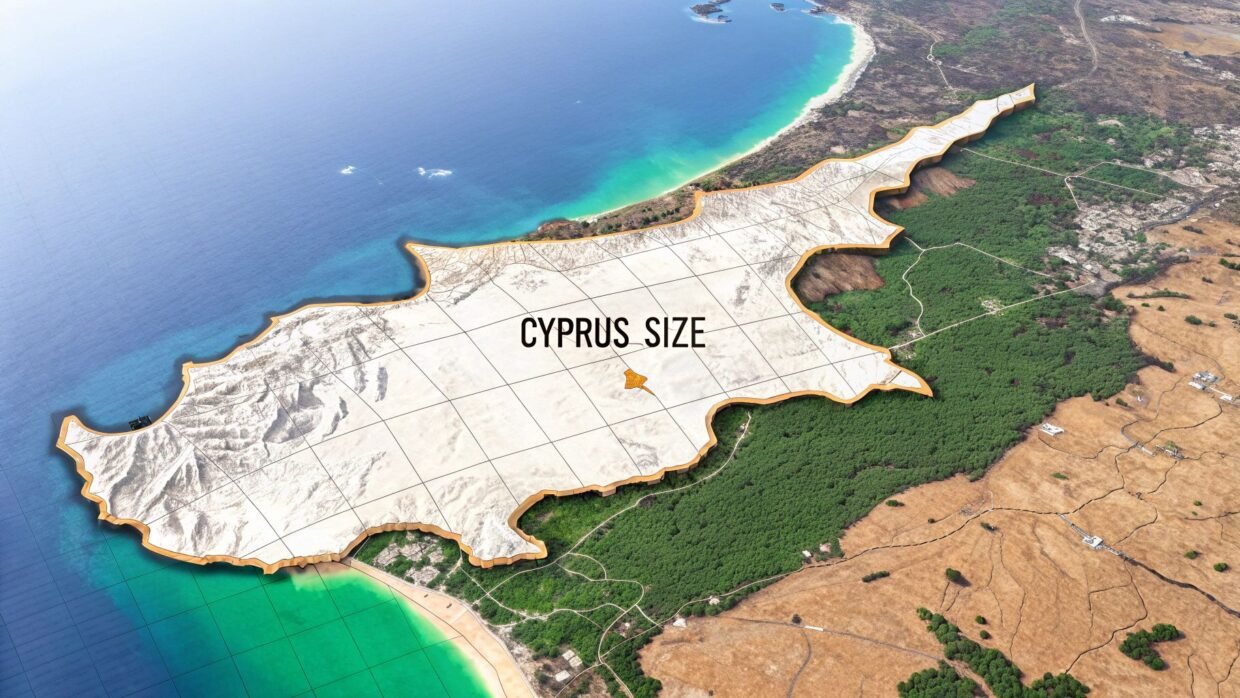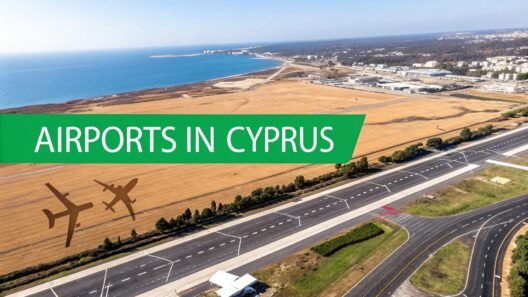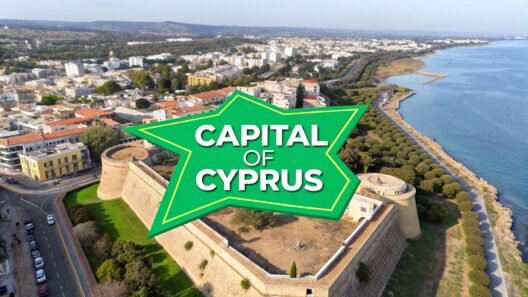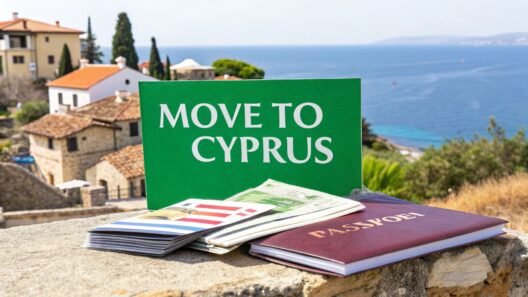So, you’re wondering just how big Cyprus is. It's a common question, and while the numbers give you a starting point, they don't quite capture the real feel of the place.
Officially, the island has a total land area of 9,251 square kilometres (3,572 sq miles), making it the third-largest island in the Mediterranean. But what does that actually mean when you’re on the ground?
Getting a Real Sense of Cyprus's Size
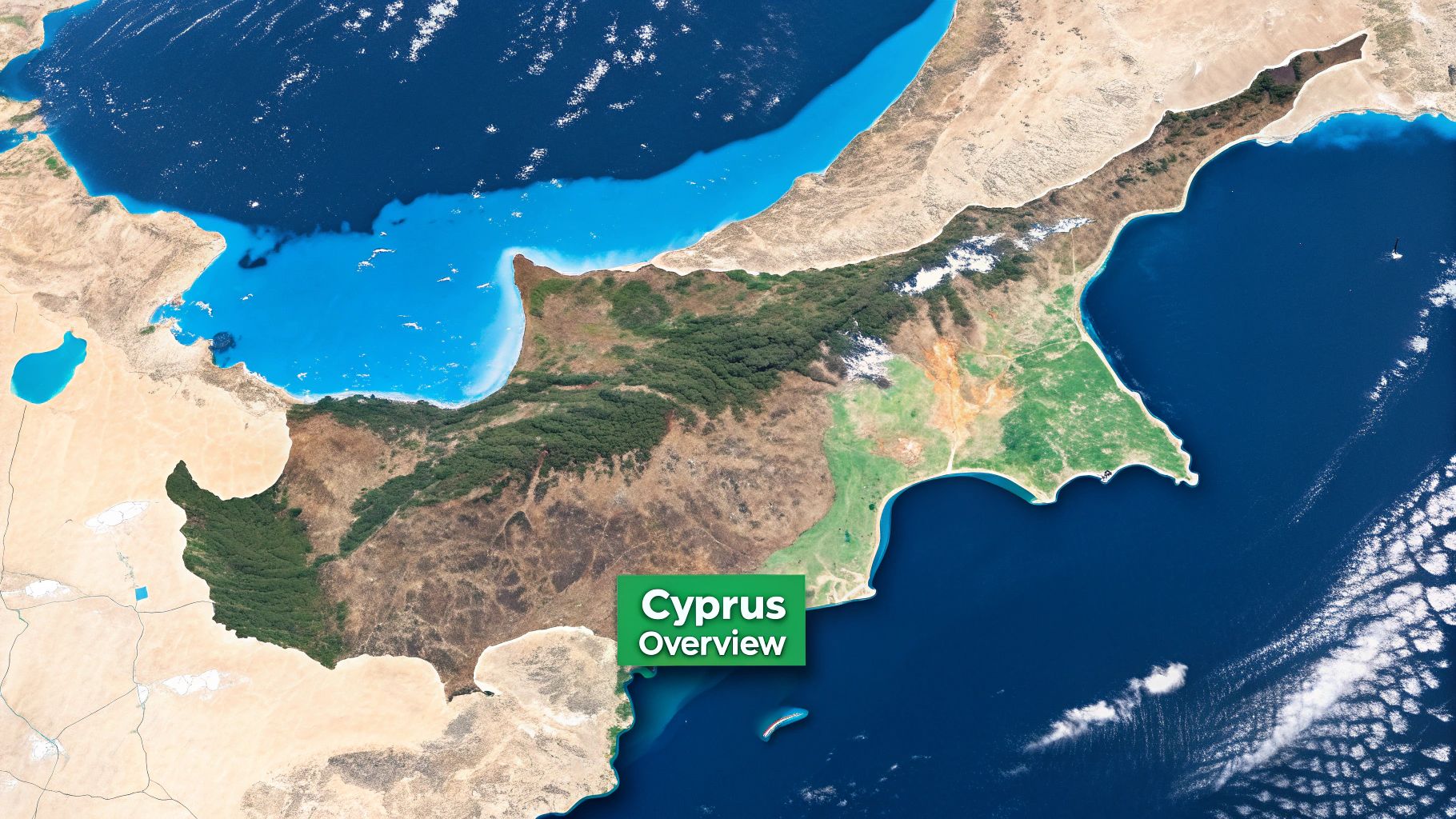
Let's move beyond the raw statistics. It’s one thing to read a number, but another thing entirely to understand what it feels like to travel across the island.
Cyprus is far more than just a sun-soaked holiday spot; it's a complete, self-contained nation packed with an incredible amount of diversity. Think about this: you can drive from the lively beaches of Ayia Napa on the east coast all the way to the ancient city of Paphos in the west in about two hours. That kind of easy access is what makes Cyprus special. Historic ruins, pine-clad mountains, and bustling cities are never more than a short trip away.
Cyprus Fact Sheet At a Glance
For those who just want the key numbers in one place, this quick summary covers the island's vital statistics. It’s a handy reference before we explore what these figures mean in a practical sense.
| Metric | Measurement |
|---|---|
| Total Area | 9,251 sq km (3,572 sq miles) |
| Mediterranean Rank | 3rd Largest Island (by area) |
| Max Length | 240 km (150 miles) East to West |
| Max Width | 100 km (62 miles) North to South |
| Coastline | 648 km (403 miles) |
This table shows why the island's combination of size and accessibility is so central to its character.
Although it’s a relatively small country on the world stage, its rank as the third largest and most populous island in the Mediterranean—right after Sicily and Sardinia—gives it real clout in the region. This strategic position has profoundly shaped its culture, history, and economy over millennia. For a deeper look, you can find more details in this trade and investment factsheet on GOV.UK.
In essence, Cyprus strikes a perfect balance. It’s large enough to offer incredibly varied landscapes and experiences, yet small enough that you can explore its different facets without spending your entire holiday on the road.
Putting Cyprus on the Map: A UK Perspective
Numbers on a page, like Cyprus's total area, don't always paint a clear picture. To really get a feel for its size, especially if you're in the UK, it helps to compare it to places and journeys you already know. It’s the difference between reading a statistic and actually imagining yourself there.

So, how big is it really? Well, picture the entire county of Devon (6,707 sq km). Now, add most of Cornwall (3,563 sq km) to it. Bolt those two together, and you've got a landmass that's a near-perfect match for Cyprus. It’s a great way to realise we're not talking about a tiny dot in the sea, but a substantial island with plenty of room for its diverse landscapes.
This isn't just a fun fact; it has real-world implications for how you'd explore the island. Its size is a huge advantage for visitors.
The brilliant thing about Cyprus's scale is that you can experience completely different worlds in a single day. You could be wandering through ancient coastal ruins in the morning sun and, by the afternoon, be hiking through the cool, pine-scented air of the Troodos Mountains.
Road Trips: Cyprus vs. The UK
Thinking in terms of drive times is another great way to get your head around the island's dimensions.
Let's say you drive from Paphos on the far west coast all the way over to Ayia Napa in the east. That’s a journey of about 170 km (105 miles). For anyone familiar with UK motorways, that’s almost identical to driving from Central London to Bristol down the M4. You're looking at a pretty standard two to two-and-a-half-hour trip.
Here are a few other common Cypriot drives to put it into context:
- Larnaca to Nicosia (47 km): Think of this as a quick jaunt from Manchester to Liverpool. It’s an easy day trip.
- Limassol to the Troodos Mountains (50 km): This is roughly the same distance as driving from Edinburgh to Glasgow, showing just how quickly you can swap city life for mountain air.
What this all means is that while Cyprus is very much its own country, it’s not overwhelmingly massive. Its size is one of its best features, making it perfectly suited for a proper holiday adventure. You can easily set up a base in one town and still see almost everything else the island has to offer on day trips.
How Cyprus Compares to Other Mediterranean Islands
We know Cyprus is the third-largest island in the Mediterranean, but what does that actually mean for your holiday plans? Getting a feel for its size next to other famous islands helps put everything into perspective. It answers the key question: can you see it all in a weekend, or do you need to set aside a week or more?
When you look at the map, Cyprus occupies a sort of "sweet spot." It's not a tiny dot like Malta, which you could comfortably drive across in less than an hour. On the other hand, it isn't a sprawling landmass like Sicily, where just getting from one side to the other is a trip in itself. For many people, Cyprus hits that perfect balance.
This infographic gives you a quick visual breakdown of the island’s vital statistics, including its area, population, and how densely populated it is.
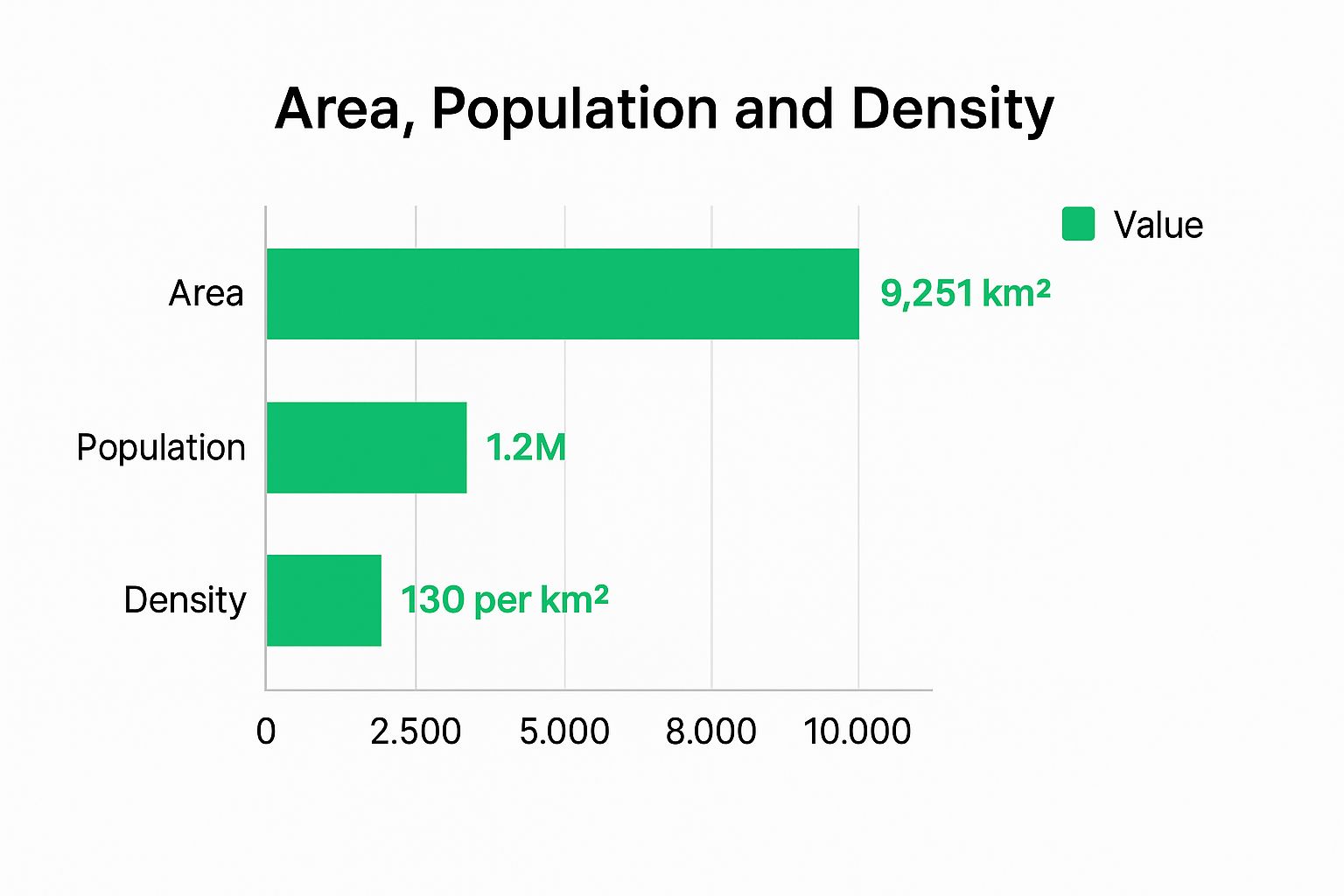
As you can see, Cyprus is substantial enough to have a diverse landscape and a thriving population, yet it never feels overwhelmingly crowded. This unique balance is a huge part of its charm.
Mediterranean Islands Size Comparison
To really nail down the context, a side-by-side comparison is the best way to see how Cyprus stacks up. Its size has a direct impact on the kind of holiday you can have.
| Island | Country | Area (sq km) | Ranking by Size |
|---|---|---|---|
| Sicily | Italy | 25,711 | 1st |
| Sardinia | Italy | 24,100 | 2nd |
| Cyprus | Cyprus | 9,251 | 3rd |
| Corsica | France | 8,680 | 4th |
| Crete | Greece | 8,336 | 5th |
| Majorca | Spain | 3,640 | 7th |
| Malta | Malta | 316 | 10th |
This table makes it clear. While giants like Sicily and Sardinia would require multiple trips to explore properly, Cyprus offers a much more manageable adventure without feeling small.
Finding the Perfect Fit
So, what does this all mean for you? Let's put these numbers into a travel context.
- Sicily (Italy): At over 25,700 sq km, Sicily is a giant. It's almost three times the size of Cyprus, and seeing it all in one go is a serious commitment.
- Crete (Greece): A bit closer in scale, Crete covers around 8,336 sq km. While still large, it gives you a similar feel to Cyprus in terms of needing a dedicated trip to explore.
- Majorca (Spain): Coming in at 3,640 sq km, Majorca is significantly smaller. You can cover a lot more ground here in just a few days.
- Malta: As the baby of the group at only 316 sq km, Malta is perfect for a short city break where you can tick off most of the highlights with ease.
Ultimately, Cyprus offers a brilliant compromise. It’s large enough to boast genuinely distinct regions—from the cool, pine-scented Troodos Mountains to the sun-drenched coastline—but small enough that you can experience that variety without spending your entire holiday just driving.
A Closer Look at the Island’s Shape and Coastline
When you move past the raw numbers, it’s the physical shape and dimensions of Cyprus that really give you a feel for what it’s like to travel around the island. Knowing its length and width helps you get a much better sense of scale, making it easier to plan your adventures and understand its varied geography.
At its very longest point, Cyprus stretches for about 240 kilometres (150 miles), all the way from its westernmost tip to the far end of the slender Karpas Peninsula in the east. At its widest, it’s roughly 100 kilometres (62 miles) from north to south. These dimensions are key; they mean that no matter where you are, almost anywhere else on the island is reachable within a day trip.
From Winding Mountains to Coastal Highways
The island's geography has a massive impact on how long it takes to get around. The vast Troodos Mountains dominate the central and western regions, where scenic but winding roads naturally slow you down. This is a world away from the flatter terrain along the southern coast, which is served by a modern motorway linking the main cities.
This constant interplay between mountains and plains means a 50-kilometre journey can take a wildly different amount of time depending on your route.
A drive up into the Troodos might take you well over an hour, while you could cover the same distance along the coast in half that time. This geographical diversity is at the very heart of the island’s character.
Finally, Cyprus has an impressive coastline measuring 648 kilometres (403 miles). That isn't just a statistic; it's a promise of endless coves, cliffs, and beaches to discover. From the world-famous sands of Ayia Napa to the wild, secluded bays of the Akamas Peninsula, there's a lifetime of exploration packed into that shoreline. This extensive coast, combined with its prime position, has defined its history for centuries. To get a better understanding of its unique place in the Mediterranean, have a read of our guide on where Cyprus is located.
How Geography Shapes the Cypriot Economy
You can't talk about Cyprus's economy without first looking at a map. An island's size and its place in the world aren't just trivia; they're the very foundation of its economic story. For Cyprus, its manageable size and strategic spot at the crossroads of Europe, Asia, and Africa have profoundly shaped its path.
This unique geography meant that large-scale manufacturing or heavy industry, which gobble up vast amounts of land and resources, were never really on the cards. Instead, Cyprus naturally leaned into its strengths, cultivating a nimble, service-based economy that thrives on its location.
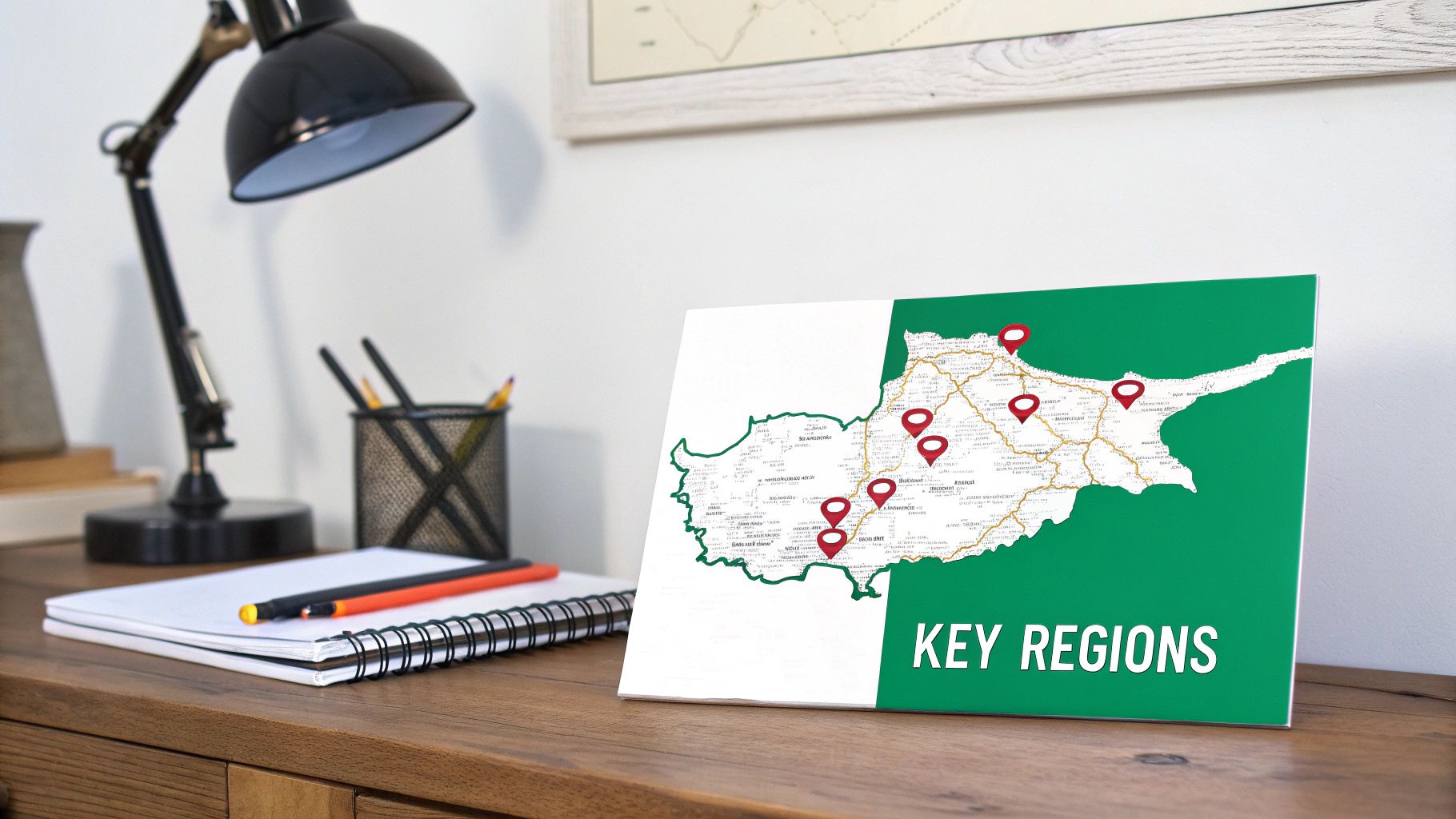
You can see this reality in what the island buys and sells. Rather than shipping out bulky industrial goods, Cyprus excels in sectors that play to its human talent and prime position. We’re talking about tourism, international finance, and professional services—all fields where expertise and connectivity matter more than sheer physical space.
A Focus on Specialised Trade
The island's trading partnerships really tell the story. Cyprus has mastered the art of importing what it can't easily produce and exporting high-value, specialised goods and services. Its trade with the United Kingdom is a perfect example of this in action.
In 2023, Cyprus imported goods from the UK worth around US$1.44 billion. What's fascinating is that a massive chunk of this, about US$1.02 billion, was for ships, boats, and other floating structures. This isn't just a random statistic; it underlines the island's crucial role as a major maritime hub, a strength that flows directly from its geographical coordinates. You can explore these commodity flows in more detail over at TradingEconomics.com.
On the flip side, Cypriot exports are often high-value products that don't need huge cargo holds, like its world-famous Halloumi cheese and pharmaceuticals. This is alongside the "invisible" exports of services that don't require a shipping container at all.
The island’s economic strategy is a direct answer to the question, "how big is Cyprus?" Its physical limits have been turned into its greatest asset, pushing it to become an agile, service-driven player on the world stage.
The Economic Impact on Daily Life
This economic DNA has a real, tangible effect on day-to-day life and the opportunities you'll find here, making the island a powerful magnet for international businesses and expats. The strong focus on finance, shipping services, and tourism has created a truly cosmopolitan vibe in cities like Limassol and Nicosia.
This unique economic setup also shapes everything from job prospects to household budgets—a vital piece of the puzzle for anyone considering a move. To get a better handle on this, check out our in-depth guide to the cost of living in Cyprus. Seeing the clear line connecting geography to the economy is the key to truly understanding how modern Cyprus works.
Getting a Real-World Feel for the Size of Cyprus
Now that we've crunched the numbers, let's put them into a real-world perspective. People often ask me practical questions to try and get a better sense of Cyprus's scale. These answers should help you understand just how big (or small) the island feels when you're actually there.
How Long Does It Take to Drive Across Cyprus?
Getting from one end of the island to the other is surprisingly manageable. If you were to drive from Paphos on the westernmost coast to the lively resort town of Ayia Napa in the east, you’d cover about 170 km (105 miles). Sticking to the main A-class motorway, you can expect that drive to take between two and two-and-a-half hours.
This is fantastic news for travellers. It means you can easily set up a base in one city and still take day trips to almost anywhere along the southern coast. A north-to-south trip, say from Nicosia down to Limassol, is even quicker—often under an hour.
This easy accessibility is one of the island's best features. You can wake up in a quiet mountain village and be relaxing on a sunny beach by lunchtime, all without spending your entire day on the road.
Is Cyprus Bigger Than Greater London?
Yes, by a long shot! Cyprus, with its total area of 9,251 square kilometres, is nearly six times larger than Greater London, which covers just 1,572 square kilometres.
This comparison really drives home the sheer diversity packed into the island. A city, no matter how vast, is still a city. Cyprus offers the varied landscapes of an entire country, from the sprawling Troodos Mountains at its core to a long and varied coastline. You simply can't find that kind of geographical range within a single city's limits.
Can You Explore All of Cyprus in One Week?
Technically, you could dash through the main highlights in a week, but it would feel incredibly rushed. A seven-day trip is ideal for getting to know one or two regions properly—perhaps exploring the Paphos district and then venturing into the Troodos Mountains for a couple of days. There are so many amazing things to do in Cyprus, and they're best enjoyed at a leisurely pace.
If you really want to experience the island’s rich culture and diverse scenery without feeling like you're in a constant race, I'd recommend a trip of 10 to 14 days. That gives you a much more realistic and enjoyable amount of time to truly soak in the unique atmosphere of each place.
How Does Cyprus Compare in Size to Wales?
Cyprus is quite a bit smaller than Wales. With Wales covering around 20,779 square kilometres, it’s more than double the size of Cyprus.
A more helpful comparison within the UK might be to think of Cyprus as being roughly the size of Devon and Cornwall combined. This gives a better mental picture of its scale: substantial enough to be full of variety, but not so vast that it feels overwhelming to explore.
At SayCyprus, we're passionate about helping you discover every corner of this incredible island. From detailed city guides to insider tips, find everything you need to plan your perfect trip at https://www.saycyprus.com.








